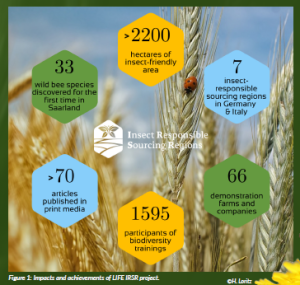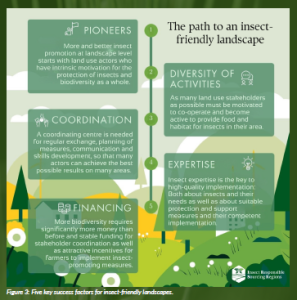Kristin Mehler, Global Nature Fund
Dr Patrick Pyttel, Lake Constance Foundation
Jenja Kronenbitter, Global Nature Fund
Anja Wischer, Lake Constance Foundation
Patrick Trötschler, Lake Constance Foundation
How can the loss of insects be counteracted?
LIFE Insect-Responsible Sourcing Regions (IRSR) aims not only to further disseminate proven measures for the promotion of pollinating insects in agriculture. The project also breaks new ground: In Insect-Responsible Sourcing Regions, a positive ecological impact is no longer limited to individual farms. Landscapes benefit holistically, and the concept is transferable to many cultivation regions in Europe.
Our goal: creating insect-responsible sourcing regions
The need to protect insects is no longer a question of ‘if’, but of ‘how’. The aim is to improve protection and create better conditions for pollinators and all insects across as large an area as possible. To achieve sustainable protection of insects and biodiversity across large, contiguous areas, various land users collaborated in the five-year IRSR project. More than
1500 people were trained, including representatives of local authorities and forestry administrations as well as numerous farmers and advisers. In seven insect-promoting regions (Allgäu, Lake Constance, Bliesgau, Hohenlohe, Northern Upper Rhine, Wendland and Vinschgau/South Tyrol), measures were implemented by more than 60 agricultural demonstration farms.
IRSR strived to build regional alliances for the promotion of insects, strengthen insect expertise, improve existing agricultural policy measures and raise consumer awareness of the importance of insect conservation.
Getting ready for the future
Measures to promote biodiversity will become more important in the future. They often offer advantages in terms of climate mitigation and sustainable adaptation to climate change, in agriculture, forestry and also in urban areas. Ultimately, these measures improve the environment for us humans.
To maximise project outreach, the IRSR project team recently published the Guidelines for More and Better Insect Promotion at Landscape Level: Recommendations for Agriculture and Forestry, Local Authorities, and Companies. Most of the measures presented have been tested in the IRSR. The aim was not only to disseminate established and proven measures to promote insects in agriculture, but also to test and strengthen the ecological effectiveness and practicability of more extensive cultivation practices. These experiences have been incorporated into the supplemented catalogue of measures.
The measures are tailored to the Central European region but can be adapted for implementation in other regions. Many of the measures can be financed by EU programmes as well as national or regional programmes. By combining different measures, a coherent network of structures can be created to promote biodiversity—an insect-promoting region. The guidelines and catalogue of measures are available for download on the project website in German and in English.
Lessons learned
The project provided ample opportunities to promote the occurrence and diversity of insects. To implement these, certain hurdles had to be overcome. These relate in particular to the operational framework conditions, training and recruitment of farm managers, marketing structures, financing and funding opportunities. If a farmer has to decide between a higher yield and the protection of a biotope, the decision is often made in favour of income, especially if there is no compensation payment. The same applies to contracts between farmers and intermediaries. If the intermediary trade considers the quantity or quality of the respective product to be at risk, for example, due to insufficient use of pesticides, the contractual agreements expire, and the farmer loses a substantial source of income. In this respect, the measures implemented as part of this project almost always required attractive compensation benefits, which sometimes also extended into the profit margins of the intermediate trade.
More innovative measures, such as the creation of beneficial flower strips or agroforestry, were in greater demand. The additional functionality and the economically relevant value of these measures, such as the provision of beneficial insects, were convincing. Significantly larger agroforestry areas could have been established if farmers had been able to reduce uncertainties regarding leasing. Only a relatively small proportion of land is usually owned by the farmer, and only there can the farmer be sure that the investment in tree rows will pay off through ecosystem functionality or the sale of valuable timber.
Our demands: what politics and the food sector should do
Insect conservation is a task that no single player can tackle alone. To promote insects effectively, we need more land—we need more than just flower strips at the edge of fields. Consequently, alliances between all land users are necessary: between agriculture—with the support of the food industry and politics—municipalities, companies and nature conservation.
The IRSR project has identified the crucial prerequisites to pave the way to an insect-friendly landscape. Pioneers who are already doing it well or who are open to new measures are helpful at the beginning—these can be farmers or local authorities. Different groups of stakeholders are also important for promoting insects, ideally working together in a well-coordinated manner. This requires someone who takes care and coordinates. High-quality implementation in the landscape requires expertise and knowledge transfer both within and to the region. And finally, money is needed for all of this—ideally, public and private funds can be combined into an investment in regional biodiversity.
More money, more flexibility, joint responsibility and capacity building
In order for these success factors to be effective, better framework conditions must be created for more and better insect and biodiversity promotion at the landscape level. This can be achieved through four main approaches:
1. Strengthening agricultural nature conservation through cooperative programmes
The cooperation of as many land users as possible in a region is the most important factor for the effective, long-term, sustainable strengthening of biodiversity. New cooperative and landscape-based funding programmes are needed to bring stakeholders together, exchange knowledge and tailor nature conservation measures to regional conditions. Such programmes should, therefore, be EU-wide, open to all relevant land-use stakeholders, and aligned with the existing LEADER structures.
2. Strengthening the attractiveness, flexibility and practicability of support programmes
A fundamental reform of agricultural support programmes is necessary to increase participation in agri-environmental measures and promote the provision of ecosystem services. Higher subsidies for ecosystem services, opening up to private investment and a flexible, practical measure design will make the programmes fit for the future and make a decisive contribution to the sustainable development of agriculture.
3. Joint responsibility of the food industry and agriculture
Together with the agricultural sector, the food industry bears a key responsibility for protecting and promoting biodiversity. The food industry is called upon to invest in biodiversity projects and to create financial incentives that reward farmers for their additional efforts in protecting biodiversity. They should also provide support for monitoring and establish initiatives to standardise requirements across the sector. In combination with public funding, synergies could be used.
4. Advice and capacity building as the key to more biodiversity
The expansion of practical biodiversity advice and the integration of biodiversity into agricultural training and education are decisive levers for the success of agri-environmental measures. They ensure the quality and acceptance of the measures, making a sustainable contribution to the protection and promotion of biodiversity at the landscape level.
What’s next?
The new EU LIFE project, Biodiversity Governance and Performance in the Food Sector (Fit for Biodiversity), has built upon the aforementioned findings, particularly the responsibility of the food industry and agriculture, as well as capacity building and strengthening of networks and cooperation. Its main focus is on effective incentive programmes from companies for farmers, capacity building for managers, auditors and accountants, as well as biodiversity credits for insetting programmes. In addition, it strives to strengthen EU-wide national initiatives to protect biodiversity and supports the monitoring through an overview of tools and key performance indicators for biodiversity assessment. For further information, please visit fitforbiodiversity.eu.
A comprehensive overview of the LIFE Insect-Responsible Sourcing Regions project is provided by the recently published Layperson’s Report, which is available for download at insect-responsible.org.
Project summary
LIFE Insect-Responsible Sourcing Regions brings together various partners to achieve a common goal: the sustainable protection of insects and biodiversity by and with different land users across larger contiguous areas. The project develops tailor-made regional biodiversity action plans in seven insect-promoting regions and creates 700 hectares of insect-friendly farmland, as well as 100 hectares of new insect-friendly habitats. This means less fertiliser, higher soil fertility and more biodiversity. In addition, trainers, advisers, and certifiers are trained, and the insect population is monitored using a specially created citizen science tool.
Project partners
Lake Constance Foundation (Coordination), Global Nature Fund, Netzwerk Blühende Landschaft, Bäuerliche Erzeugergemeinschaft Schwäbisch Hall, Nestlé Germany.
Project lead profile
Patrick Trötschler is an agricultural engineer and serves as both Managing Director of the Lake Constance Foundation and Programme Manager for its Agriculture & Food initiative. In these roles, he has been committed to implementing greater sustainability in agriculture and the food industry. For over 23 years, Trötschler has played a key role in shaping the Foundation’s profile as a reliable partner. He advises farms, producer organisations, and food industry companies (processing and trade) on biodiversity, climate protection and climate change adaptation.
Project contacts
Bodensee-Stiftung Patrick Trötschler
Fritz-Reichle-Ring 4, 78315 Radolfzell Germany
p.troetschler@bodensee-stiftung.org
https://insect-responsible.org/en/
Funding disclaimer
This project has been funded by the European Union (EU) under the European Union’s LIFE programme – grant agreement number LIFE19 GIE/DE/000785.
Views and opinions expressed are however those of the author(s) only and do not necessarily reflect those of the European Union or the LIFE Programme. Neither the European Union nor the granting authority can be held responsible for them.
Figure legends
Figure 1: Impacts and achievements of LIFE IRSR project.
Figure 2: Guidelines.
Figure 3: Five key success factors for insect-friendly landscapes.




